
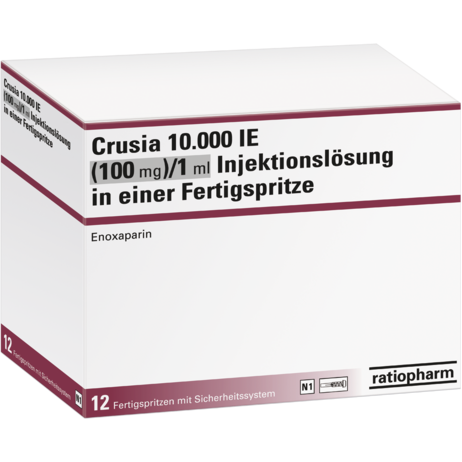
Crusia

Ask a doctor about a prescription for Crusia

How to use Crusia
Leaflet accompanying the packaging: patient information
Crusia, 2000 IU (20 mg)/0.2 ml, solution for injection in a pre-filled syringe
Crusia, 4000 IU (40 mg)/0.4 ml, solution for injection in a pre-filled syringe
Crusia, 6000 IU (60 mg)/0.6 ml, solution for injection in a pre-filled syringe
Crusia, 8000 IU (80 mg)/0.8 ml, solution for injection in a pre-filled syringe
Crusia, 10,000 IU (100 mg)/1 ml, solution for injection in a pre-filled syringe
This medicinal product is subject to additional monitoring. This will allow for quick identification of new safety information. You can help by reporting any side effects you may get. To find out how to report side effects, see section 4.
Enoxaparin sodium
You should carefully read the contents of this leaflet before using the medicinal product, as it contains important information for the patient.
- You should keep this leaflet, so that you can read it again if you need to.
- If you have any further questions, you should ask your doctor, pharmacist, or nurse.
- This medicinal product has been prescribed specifically for you. Do not pass it on to others. It may harm them, even if their symptoms are the same as yours.
- If you experience any side effects, including those not listed in this leaflet, you should tell your doctor or pharmacist. See section 4.
Table of contents of the leaflet
- 1. What is Crusia and what is it used for
- 2. Important information before using Crusia
- 3. How to use Crusia
- 4. Possible side effects
- 5. How to store Crusia
- 6. Contents of the packaging and other information
1. What is Crusia and what is it used for
Crusia contains the active substance enoxaparin sodium, which is a low molecular weight heparin (LMWH).
Crusia works in two ways.
- 1) It prevents the growth of existing blood clots. This helps the body to dissolve existing blood clots, making them no longer harmful.
- 2) It prevents the formation of new blood clots in the patient's blood.
Crusia can be used for:
- Treating blood clots that are already present in the patient's blood.
- Preventing the formation of blood clots in the patient's blood in the following situations: before and after surgery, during acute illness when the patient has limited mobility, if the patient has had blood clots caused by cancer to prevent the formation of new clots, in unstable angina (a condition where the heart does not receive enough blood), after a heart attack
- Preventing the formation of clots in the dialyzer tubes (used in people with severe kidney function disorders)
in patients with severe kidney function disorders.
2. Important information before using Crusia
When not to use Crusia
- If you are allergic to enoxaparin sodium or any of the other ingredients of this medicinal product (listed in section 6). Symptoms of an allergic reaction may include: rash, difficulty swallowing or breathing, swelling of the mouth, face, throat, or tongue.
- If you have been diagnosed with an allergy to heparin or other low molecular weight heparins, such as nadroparin, tinzaparin, or dalteparin.
- If you have been diagnosed with a reaction to heparin that has caused a significant decrease in the number of blood cells responsible for blood clotting (platelets) - a reaction known as heparin-induced thrombocytopenia - in the last 100 days or if you have antibodies against enoxaparin in your blood.
- If you have severe bleeding or a medical condition associated with an increased risk of bleeding (such as stomach ulcers, recent brain or eye surgery), including recent hemorrhagic stroke.
- If you are using Crusia to treat blood clots and spinal or epidural anesthesia is planned.
Warnings and precautions
Crusia should not be used interchangeably with other low molecular weight heparins. This is because they are not exactly the same, differ in activity, and have different instructions for use.
Before starting to use Crusia, you should discuss this with your doctor or pharmacist if:
- you have ever had a reaction to heparin that has caused a significant decrease in the number of platelets in your blood
- you are scheduled to have spinal or epidural anesthesia (see "Surgical procedures and anesthetics")
- you have a heart valve replacement
- you have endocarditis (an infection of the membrane lining the heart)
- you have had stomach ulcers
- you have recently had a stroke
- you have high blood pressure
- you have diabetes or have problems with blood vessels in the eyes caused by diabetes (so-called diabetic retinopathy)
- you have recently had eye or brain surgery
- you are elderly (over 65 years old), especially if you are over 75 years old
- you have kidney disease
- you have liver disease
- you are underweight or overweight
- you have a high level of potassium in your blood (which can be checked with a blood test)
- you are currently taking medications that may cause bleeding (see below "Crusia and other medications")
Before starting to use this medicinal product and periodically during its use, you may have blood tests to check the number of platelets in your blood and the level of potassium in your blood.
Children and adolescents:
The safety and efficacy of enoxaparin have not been evaluated in children and adolescents.
Crusia and other medications
You should tell your doctor or pharmacist about all medications you are currently taking or have recently taken, as well as any medications you plan to take.
- Warfarin - a medication used to thin the blood
- Aspirin (also known as acetylsalicylic acid or ASA), clopidogrel, or other medications used to prevent blood clots (see also section 3 "Change of anticoagulant medication")
- Dextrans - used as a blood substitute
- Ibuprofen, diclofenac, ketorolac, or other non-steroidal anti-inflammatory medications used to treat pain and swelling in arthritis and other conditions
- Prednisolone, dexamethasone, or other medications used to treat asthma, rheumatoid arthritis, and other conditions
- Medications that increase potassium levels in the blood, such as potassium salts, diuretics, and certain heart medications.
Surgical procedures and anesthetics
If you are scheduled to have a lumbar puncture or surgery under spinal or epidural anesthesia, you should inform your doctor that you are using Crusia. See "When not to use Crusia". Additionally, you should inform your doctor if you have any spinal problems or if you have had spinal surgery.
Pregnancy and breastfeeding
If you are pregnant or breastfeeding, think you may be pregnant, or plan to have a child, you should consult your doctor or pharmacist before using this medicinal product.
Women with mechanical heart valves may have an increased risk of blood clots. Your doctor should discuss this with you.
Women who are breastfeeding or plan to breastfeed should consult their doctor before starting to use this medicinal product.
Driving and using machines
Crusia does not affect the ability to drive or use machines.
Your doctor should document the trade name and batch number of the product used.
Crusia contains sodium
This medicinal product contains less than 1 mmol (23 mg) of sodium per dose, which means that it is essentially "sodium-free".
3. How to use Crusia
This medicinal product should always be used exactly as prescribed by your doctor or pharmacist. If you are unsure, you should ask your doctor or pharmacist.
Administration of the medicinal product
- Crusia is usually administered to the patient by a doctor or nurse. This is because it requires injection.
- After returning home, you may need to continue using Crusia and administer it yourself (see the administration instructions below).
- Crusia is usually administered subcutaneously.
- Crusia may be administered intravenously after certain types of heart attack or after surgery.
- Crusia may be introduced into the dialyzer tube returning blood from the body (into the so-called arterial line) at the start of the dialysis session. Crusia should not be administered intramuscularly.
Dose of the medicinal product
- Your doctor will decide what dose of Crusia you should take. This depends on the reason for using the medicinal product.
- In patients with kidney disease, you may receive a lower dose of Crusia.
- 1. Treatment of blood clots in the patient's blood
- The usual dose is 150 IU (1.5 mg) per kilogram of body weight once daily or 100 IU (1 mg) per kilogram of body weight twice daily.
- Your doctor will decide how long you should receive Crusia.
- 2. Prevention of blood clot formation in the patient's blood in the following situations:
- Surgical procedure or period of limited mobility due to illness
- The dose depends on the patient's risk of blood clot formation. You will receive Crusia at a dose of 2000 IU (20 mg) or 4000 IU (40 mg) per day.
- In the case of planned surgery, the first injection is usually performed 2 hours or 12 hours before surgery.
- If you have limited mobility due to illness, you will usually receive Crusia at a dose of 4000 IU (40 mg) per day.
- Your doctor will decide how long you should receive Crusia.
- After a heart attackCrusia can be used in two different types of heart attack: heart attack with ST-segment elevation (STEMI) and heart attack without ST-segment elevation (NSTEMI). The dose of Crusia will depend on your age and the type of heart attack you have had.
Non-ST-segment elevation heart attack (NSTEMI):
- The usual dose of Crusia is 100 IU (1 mg) per kilogram of body weight every 12 hours.
- Your doctor will usually recommend that you also take aspirin (acetylsalicylic acid).
- Your doctor will decide how long you should receive Crusia.
ST-segment elevation heart attack (STEMI) in patients under 75 years of age:
- The initial dose of Crusia is 3000 IU (30 mg) administered intravenously.
- Crusia is also administered subcutaneously. The usual dose is 100 IU (1 mg) per kilogram of body weight every 12 hours.
- Your doctor will usually recommend that you also take aspirin (acetylsalicylic acid).
- Your doctor will decide how long you should receive Crusia.
ST-segment elevation heart attack (STEMI) in patients 75 years of age or older:
- The usual dose is 75 IU (0.75 mg) per kilogram of body weight every 12 hours.
The maximum amount of Crusia in the first two doses is 7500 IU (75 mg).
- Your doctor will decide how long you should receive Crusia.
Patient undergoing percutaneous coronary intervention (PCI):
Depending on when the last dose of Crusia was administered, your doctor may decide to administer an additional dose of Crusia before the PCI procedure.
This will be administered intravenously.
- 3. Prevention of blood clot formation in the dialyzer tubes
- The usual dose is 100 IU (1 mg) per kilogram of body weight.
- Crusia is injected into the tube returning blood from the body (into the so-called arterial line) at the start of the dialysis session. This dose is usually sufficient for a 4-hour dialysis session. However, if necessary, your doctor may administer an additional dose of 50 IU to 100 IU (0.5 to 1 mg) per kilogram of body weight.
Instructions for using the pre-filled syringe
Self-administration of Crusia
If you are able to administer Crusia yourself, your doctor or nurse will show you how to do it. Do not attempt to administer the injection yourself until you have received instructions.
If you are unsure, you should talk to your doctor or nurse immediately. Proper administration of the injection under the skin (so-called subcutaneous injection) will help reduce pain and bruising at the injection site.
Before self-administering Crusia
- Gather the necessary items: syringe, cotton ball or soap and water, and a container for sharp objects.
- Check the expiration date on the packaging. Do not use the medicinal product after the expiration date.
- Check if the syringe is damaged and if the liquid is clear. If not, use another syringe.
- Make sure you know what dose you are supposed to administer.
- Examine your abdomen to check if the last injection caused redness, discoloration, swelling, discharge, or if it is still painful. If so, you should talk to your doctor or nurse.
Instructions for self-administering Crusia:
(Instructions for pre-filled syringes without a safety device)
Preparing the injection site
- 1) Choose an injection site on the right or left side of your abdomen. The injection site should be at least 5 cm away from the navel towards the sides.
- Do not inject within 5 cm of the navel or around existing scars or bruises.
- You should alternate injection sites between the left and right side of your abdomen, depending on the site of the previous injection.

- 2) Wash your hands. Clean (do not rub) the injection site with a cotton ball soaked in alcohol or soap and water.
- 3) You should sit or lie down in a comfortable position, so that you are relaxed. You should make sure that the injection site is within your sight. A chair, couch, or bed with pillows for support will be suitable.
Choosing the dose
- 1) Carefully remove the needle cap from the syringe. The cap should be discarded.
- Do not press the plunger before administering the injection to remove air bubbles. This may reduce the administered dose.
- After removing the cap, do not touch anything with the needle. This will ensure the sterility of the needle.
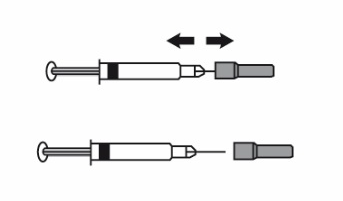
- 2) If the amount of medicinal product in the syringe is consistent with the prescribed dose, there is no need to adjust the dose. You can administer the injection.
- 3) If the dose depends on your body weight, you may need to adjust the dose in the syringe according to the prescribed dose. In this case, you should get rid of the excess medicinal product by holding the syringe with the needle facing down (to keep the air bubbles in the syringe) and removing the excess medicinal product into a container.
- 4) A drop may appear at the tip of the needle. In this case, you should remove the drop before administering the injection by tapping the syringe with the needle facing down. You can now administer the injection.
Administering the injection
- 1) Hold the syringe in the hand you write with (like a pencil). With your other hand, gently grasp the cleaned skin of your abdomen with your index finger and thumb, creating a fold of skin between your fingers.
- You should make sure that you maintain the skin fold while administering the injection.
- 2) Hold the syringe with the needle facing down (perpendicularly at a 90-degree angle). Insert the entire length of the needle into the skin fold.
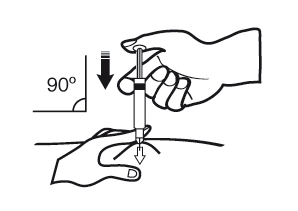
- 3) Press the plunger with your thumb. This will introduce the medicinal product into the abdominal fat tissue. You should administer the entire amount of medicinal product from the syringe.
- 4) Remove the needle from the injection site, pulling it out straight. Hold the needle away from yourself and others. You can now release the skin fold.
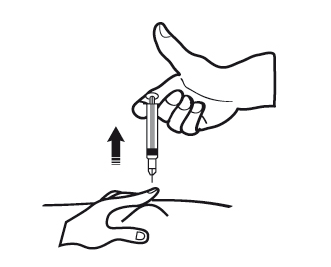
After administering the injection
- 1) To avoid bruising, do not rub the injection site after administering the injection.
- 2) Dispose of the used syringe in a container for sharp objects. Close the container and store it in a place that is out of sight and reach of children. If the container is full, dispose of it according to the instructions of your doctor or pharmacist.
Any unused medicinal product or waste should be disposed of in accordance with local regulations.
If you feel that the dose is too strong (for example, unexpected bleeding occurs) or too weak (for example, the dose probably does not work), you should consult your doctor or pharmacist.
Instructions for pre-filled syringes with a safety device:
Preparing the injection site
- 1) Choose an injection site on the right or left side of your abdomen. The injection site should be at least 5 cm away from the navel towards the sides.
- Do not inject within 5 cm of the navel or around existing scars or bruises.
- You should alternate injection sites between the left and right side of your abdomen, depending on the site of the previous injection.

- 2) Wash your hands. Clean (do not rub) the injection site with a cotton ball soaked in alcohol or soap and water.
- 3) You should sit or lie down in a comfortable position, so that you are relaxed. You should make sure that the injection site is within your sight. A chair, couch, or bed with pillows for support will be suitable.
Choosing the dose
- 1) Carefully remove the needle cap from the syringe. The cap should be discarded.
- Do not press the plunger before administering the injection to remove air bubbles. This may reduce the administered dose.
- After removing the cap, do not touch anything with the needle. This will ensure the sterility of the needle.
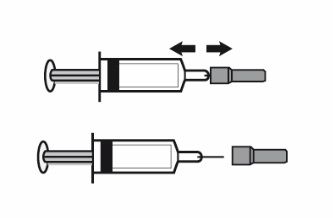
- 2) If the amount of medicinal product in the syringe is consistent with the prescribed dose, there is no need to adjust the dose. You can administer the injection.
- 3) If the dose depends on your body weight, you may need to adjust the dose in the syringe according to the prescribed dose. In this case, you should get rid of the excess medicinal product by holding the syringe with the needle facing down (to keep the air bubbles in the syringe) and removing the excess medicinal product into a container.
- 4) A drop may appear at the tip of the needle. In this case, you should remove the drop before administering the injection by tapping the syringe with the needle facing down. You can now administer the injection.
Administering the injection
- 1) Hold the syringe in the hand you write with (like a pencil). With your other hand, gently grasp the cleaned skin of your abdomen with your index finger and thumb, creating a fold of skin between your fingers.
- You should make sure that you maintain the skin fold while administering the injection.
- 2) Hold the syringe with the needle facing down (perpendicularly at a 90-degree angle). Insert the entire length of the needle into the skin fold.
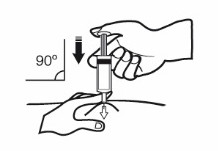
- 3) Press the plunger with your thumb. This will introduce the medicinal product into the abdominal fat tissue. You should administer the entire amount of medicinal product from the syringe.
- 4) Remove the needle from the injection site, pulling it out straight, while still holding your fingers on the plunger. Hold the needle away from yourself and others. The safety device is activated by firmly pressing the plunger. The protective cover will automatically cover the needle and a clicking sound will be heard, confirming the activation of the protective cover. You can now release the skin fold.
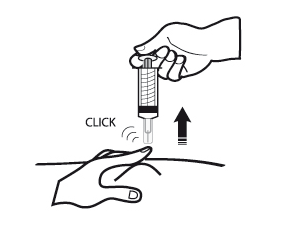
After administering the injection
- 1) To avoid bruising, do not rub the injection site after administering the injection.
- 2) Dispose of the used syringe in a container for sharp objects. Close the container and store it in a place that is out of sight and reach of children. If the container is full, dispose of it according to the instructions of your doctor or pharmacist.
Any unused medicinal product or waste should be disposed of in accordance with local regulations.
If you feel that the dose is too strong (for example, unexpected bleeding occurs) or too weak (for example, the dose probably does not work), you should consult your doctor or pharmacist.
Change of anticoagulant medication
- Change from Crusia to medications that thin the blood, known as vitamin K antagonists (e.g. warfarin)Your doctor will recommend that you have blood tests to determine the INR (International Normalized Ratio) and, based on this, will inform you when to stop taking Crusia.
- Change from vitamin K antagonists (e.g. warfarin) to CrusiaYou should stop taking the vitamin K antagonist. Your doctor will recommend that you have blood tests to determine the INR and, based on this, will inform you when to start taking Crusia.
- Change from Crusia to direct oral anticoagulantsYou should stop taking Crusia. Then, you should start taking the direct oral anticoagulant 0-2 hours before the scheduled time of the next injection; and then you should continue taking the medication as usual.
- Change from direct oral anticoagulant to CrusiaYou should stop taking the direct oral anticoagulant. Treatment with Crusia can be started only after 12 hours from the last dose of the direct oral anticoagulant.
Use of a higher than recommended dose of Crusia
If you think you have used too much or too little Crusia, you should immediately inform your doctor, nurse, or pharmacist, even if you do not notice any problems. If a child has accidentally injected or ingested Crusia, you should immediately go to the hospital emergency department.
Missing a dose of Crusia
If you miss a dose, you should take it as soon as possible. Do not take a double dose to make up for the missed dose. Keeping a diary will help you make sure you do not miss a dose.
Stopping the use of Crusia
If you have any further questions about the use of this medicinal product, you should ask your doctor, pharmacist, or nurse.
It is important to continue administering Crusia injections until your doctor tells you to stop. If you stop the treatment, a blood clot may form, which can be very dangerous.
4. Possible side effects
Like all medicinal products, Crusia can cause side effects, although not everybody gets them.
As with other similar medicinal products (used to reduce blood clotting), Crusia may cause bleeding, which can be life-threatening. In some cases, the bleeding may not be immediately visible.
If you experience any bleeding that does not stop on its own, as well as signs of excessive bleeding (severe weakness, fatigue, paleness, dizziness, headaches, or unexplained sweating), you should immediately consult your doctor. Your doctor may decide to monitor you more closely or change your medication.
If you experience any of the following symptoms, you should stop using enoxaparin and seek medical help immediately:
- Any symptoms of a severe allergic reaction (such as difficulty breathing, swelling of the lips, mouth, throat, or eyes).
- A red, scaly, widespread rash with thickening of the skin and blisters, accompanied by fever.
You should immediately consult your doctor:
- If you experience any signs of a blood clot blocking a blood vessel, such as:
- cramping pain, redness, increased warmth, or swelling in one of your legs - these are symptoms of deep vein thrombosis
- shortness of breath, chest pain, fainting, or coughing up blood - these are symptoms of pulmonary embolism
- If you experience painful bruising or dark red spots under the skin that do not fade when pressed. Your doctor may order blood tests to check your platelet count.
Summary of possible side effects:
Very common (may affect more than 1 in 10 people)
- Bleeding.
- Increased liver enzyme activity.
Common (may affect up to 1 in 10 people)
- Increased tendency to bruise. This may be due to a decrease in the number of platelets in your blood.
- Pink spots on the skin. These changes are more likely to occur at the injection sites of Crusia.
- Hives (urticaria).
- Itching, redness of the skin.
- Bruising or pain at the injection site.
- Decreased red blood cell count.
- Increased platelet count.
- Headache.
Uncommon (may affect up to 1 in 100 people)
- Sudden severe headache. This may be a sign of bleeding into the brain.
- Tenderness and swelling of the abdomen. This may be a sign of bleeding into the stomach.
- Large, red, irregularly-shaped skin changes with blisters, with or without blisters.
- Skin irritation (local irritation).
- You may notice yellowing of the skin or eyes and darker urine. This may indicate liver disease.
Rare (may affect up to 1 in 1,000 people)
- Severe allergic reaction. Symptoms of such a reaction may include: rash, difficulty swallowing or breathing, swelling of the lips, face, throat, or tongue.
- High level of potassium in the blood. This is more likely to occur in people with kidney disease or diabetes. Your doctor may check this with a blood test.
- Increased eosinophil count in the blood. Your doctor may check this with a blood test.
- Hair loss.
- Osteoporosis (a condition in which bones are more prone to fractures) after long-term use of the medicinal product.
- Numbness, tingling, and muscle weakness (especially in the lower part of the body) after lumbar puncture or spinal anesthesia.
- Loss of control over the bladder or bowels (a condition in which you are unable to control when you go to the toilet).
- Hardening or lump at the injection site.
Reporting side effects
If you experience any side effects, including those not listed in this leaflet, you should tell your doctor, pharmacist, or nurse. Side effects can be reported directly to the Department of Drug Safety Monitoring of the Office for Registration of Medicinal Products, Medical Devices, and Biocidal Products, Al. Jerozolimskie 181C, 02-222 Warsaw, tel.: +48 22 49 21 301, fax: +48 22 49 21 309, website: https://smz.ezdrowie.gov.pl
Side effects can also be reported to the marketing authorization holder.
By reporting side effects, you can help provide more information on the safety of this medicinal product.
5. How to store Crusia
Store in a temperature below 25°C. Do not freeze.
Crusia pre-filled syringes are single-dose containers - any unused product should be discarded.
The medicinal product should be stored in a place that is out of sight and reach of children.
Do not use this medicinal product after the expiration date stated on the packaging. The expiration date refers to the last day of the specified month.
Do not use the medicinal product if the pre-filled syringe is damaged or if the product is not clear.
Medicinal products should not be disposed of via wastewater or household waste. You should ask your pharmacist how to dispose of medicinal products that are no longer needed. This will help protect the environment.
6. Contents of the packaging and other information
What Crusia contains
- The active substance is enoxaparin sodium.
Each pre-filled syringe contains enoxaparin sodium equivalent to 2000 IU of anti-Xa activity (which corresponds to 20 mg) in 0.2 ml of water for injections.
Each pre-filled syringe contains enoxaparin sodium equivalent to 4000 IU of anti-Xa activity (which corresponds to 40 mg) in 0.4 ml of water for injections.
Each pre-filled syringe contains enoxaparin sodium equivalent to 6000 IU of anti-Xa activity (which corresponds to 60 mg) in 0.6 ml of water for injections.
Each pre-filled syringe contains enoxaparin sodium equivalent to 8000 IU of anti-Xa activity (which corresponds to 80 mg) in 0.8 ml of water for injections.
Each pre-filled syringe contains enoxaparin sodium equivalent to 10,000 IU of anti-Xa activity (which corresponds to 100 mg) in 1.0 ml of water for injections.
- The other ingredient is water for injections.
What Crusia looks like and contents of the packaging
Crusia is a clear, colorless to pale yellow solution for injection in a pre-filled syringe made of glass type I with a rubber stopper, plunger, and needle in a protective sleeve, with or without an automatic safety device. It is available in the following forms:
Crusia 2000 IU (20 mg)/0.2 ml solution for injection in a 0.5 ml pre-filled syringe without graduation.
Packaging of 2, 6, 10, 20, and 50 pre-filled syringes.
Crusia 4000 IU (40 mg)/0.4 ml solution for injection in a 0.5 ml pre-filled syringe without graduation.
Packaging of 2, 6, 10, 20, 30, and 50 pre-filled syringes.
Crusia 6000 IU (60 mg)/0.6 ml solution for injection in a 1 ml pre-filled syringe.
Packaging of 2, 6, 10, 12, 24, 30, and 50 pre-filled syringes.
Crusia 8000 IU (80 mg)/0.8 ml solution for injection in a 1 ml pre-filled syringe.
Packaging of 2, 6, 10, 12, 24, 30, and 50 pre-filled syringes.
Crusia 10,000 IU (100 mg)/1 ml solution for injection in a 1 ml pre-filled syringe.
Packaging of 2, 6, 10, 12, 24, 30, and 50 pre-filled syringes.
Not all pack sizes may be marketed.
In some pack sizes, the pre-filled syringes may be connected to a safety device.
Marketing authorization holder and manufacturer:
Marketing authorization holder:
Laboratorios Farmacéuticos Rovi, S.A.
Julián Camarillo, 35
28037 Madrid
Spain
tel.: (+48) 699 711 147
Manufacturer:
ROVI Pharma Industrial Services S.A.
Julián Camarillo, 35
28037 Madrid
Spain
This medicinal product is authorized in the Member States of the European Economic Area and in the United Kingdom (Northern Ireland) under the following names:
Austria, Denmark, Finland, Netherlands, Germany, Norway, Sweden, United Kingdom (Northern Ireland), Spain, Portugal, Greece, Bulgaria, Czech Republic, Estonia, Croatia, Hungary, Latvia, Poland, Romania, Slovakia: Crusia
France: Enoxaparine Crusia
Italy: Rovinadil
Belgium, Ireland, Slovenia, Luxembourg: Teuro
Date of last revision of the leaflet: 01/2023
Other sources of information
Detailed information on this medicinal product is available on the website of the Office for Registration of Medicinal Products, Medical Devices, and Biocidal Products: http://www.urpl.gov.pl/
- Country of registration
- Active substance
- Prescription requiredYes
- Manufacturer
- ImporterRovi Pharma industrial Services, S.A.
- This information is for reference only and does not constitute medical advice. Always consult a licensed doctor before taking any medication. Oladoctor is not responsible for medical decisions based on this content.
- Alternatives to CrusiaDosage form: Solution, 12,000 IU (120 mg)/0.8 mlActive substance: enoxaparinPrescription requiredDosage form: Solution, 15,000 IU (150 mg)/mlActive substance: enoxaparinPrescription requiredDosage form: Solution, 2000 IU (20 mg)/0.2 mlActive substance: enoxaparin
Alternatives to Crusia in other countries
The best alternatives with the same active ingredient and therapeutic effect.
Alternative to Crusia in Spain
Alternative to Crusia in Ukraine
Online doctors for Crusia
Discuss dosage, side effects, interactions, contraindications, and prescription renewal for Crusia – subject to medical assessment and local rules.














